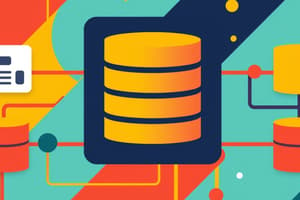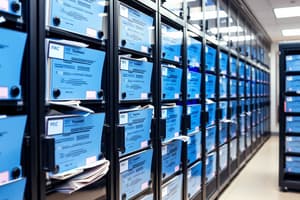Podcast
Questions and Answers
What is the role of a Database Administrator in a database system?
What is the role of a Database Administrator in a database system?
To manage the DBMS’s use and ensure that the database is functioning properly.
Who is responsible for designing the database structure?
Who is responsible for designing the database structure?
Database designers.
What type of database application is used by a single user at a time?
What type of database application is used by a single user at a time?
Personal Database Application or Single-User Database.
What is the typical size of data in a Single-User Database?
What is the typical size of data in a Single-User Database?
What is a Multi-User Database also known as?
What is a Multi-User Database also known as?
How many users can a Multi-User Database typically support?
How many users can a Multi-User Database typically support?
What is the typical size of data in a Multi-User Database?
What is the typical size of data in a Multi-User Database?
What type of database is used by an entire organization and supports many users across many departments?
What type of database is used by an entire organization and supports many users across many departments?
Who uses the application programs to run the organization’s daily operations?
Who uses the application programs to run the organization’s daily operations?
Who designs and implements the application programs?
Who designs and implements the application programs?
Flashcards
Wisdom
Wisdom
The top level of the DIKW hierarchy; involves applying knowledge to choose the best course of action.
File System
File System
A method for storing data electronically as individual files, where each file contains a single table.
Database
Database
A structured collection of related data organized into tables.
Database Management System (DBMS)
Database Management System (DBMS)
Signup and view all the flashcards
Advantages of DBMS
Advantages of DBMS
Signup and view all the flashcards
Disadvantages of DBMS
Disadvantages of DBMS
Signup and view all the flashcards
Database components
Database components
Signup and view all the flashcards
Personal Database Application
Personal Database Application
Signup and view all the flashcards
Multi-User Database Application
Multi-User Database Application
Signup and view all the flashcards
Organizational Database Application
Organizational Database Application
Signup and view all the flashcards
Study Notes
DIKW Hierarchy
- Wisdom is the top of the DIKW hierarchy, requiring answers to questions like 'why do something' and 'what is best'.
- Wisdom involves knowledge applied in action.
File System
- A file system stores data electronically in files, with each file storing only one table (flat file).
- File systems can be stored in physical locations like hard drives, CDs, DVDs, and flash drives.
- Benefits of file systems include:
- Easy to implement and understand
- No need for technical staff
- Less skills required
- High processing speed
- Low hardware and software requirements
- Suitable for small databases
- Drawbacks of file systems include:
- Less security
- Data inconsistency
- Data and program dependence
- More redundancy
- Limited sharing of information
- Slow searching process
- High complexity when updating
- Difficulty in accessing data
Database Concepts
- A database is a collection of interrelated data organized into tables.
- A database is an integrated collection of stored operational data used by an enterprise's application systems.
- Examples of databases include university databases and library databases.
Database Examples
- University database: stores information related to students, courses, and grades.
- Library database: records data concerning books, such as titles, authors, and publication details.
Benefits of Database
- Stored data
- Easy to use
- Reduced data redundancy
- Reduced complexity
- Controlled data inconsistency
- Maintained data integrity
- Improved data security
- Fast searching
- Handles large numbers of data
- Shared data among users
- Easy access to information
- Provides backup and recovery
Database Management Systems (DBMS)
- Definition: a collection of tools used to create, maintain, and manage databases.
- Four basic DBMS functions:
- Create, modify, and remove tables
- Add, modify, and delete data
- Retrieve data selectively
- Generate reports
DBMS Software Types
-
- Relational Database Software (e.g., Microsoft Access, Oracle, Sybase, Paradox)
-
- Flat-File Database Software (e.g., simple applications like mailing lists or personnel files)
Advantages of DBMS
- Sharing of information
- Fast response to information requests
- Multiple access
- Minimized redundancy
- Less storage
- Accuracy and data integrity
- User-friendly
- Improved security
- Provides backup and recovery
Disadvantages of DBMS
- Costly implementation and maintenance
- Time-consuming training requirements
Database System Components
-
- Data: stored in a single database, shared and integrated.
-
- Hardware: physical devices, including processors, main memory, and secondary storage devices.
-
- Software: DBMS, operating system software, and application programs.
-
- Users: system administrators, database administrators, database designers, system programmers, and end-users.
Database Management System Applications
-
- Personal Database Application (Single-User DB Application)
- Characteristics: single-user, small amount of data (<10 MB), simple forms and reports.
-
- Multi-User Database Application (Workgroup Database)
- Characteristics: supports multiple users (<50), complex forms and reports, data size <100 MB.
-
- Organizational Database Application (Enterprise Database)
- Used by entire organization, supporting many users across departments.
Studying That Suits You
Use AI to generate personalized quizzes and flashcards to suit your learning preferences.




